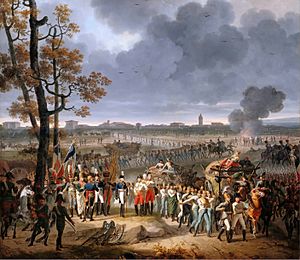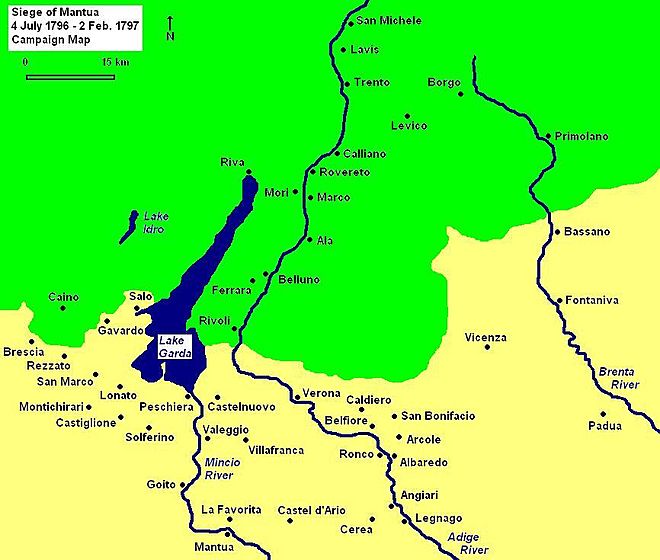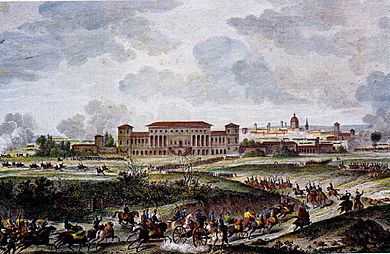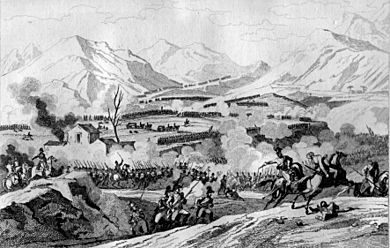Siege of Mantua (1796–1797) facts for kids
Quick facts for kids Siege of Mantua (1796–1797) |
|||||||
|---|---|---|---|---|---|---|---|
| Part of the Italian campaigns in the War of the First Coalition | |||||||
 General Wurmser surrenders to General Sérurier. |
|||||||
|
|||||||
| Belligerents | |||||||
| Commanders and leaders | |||||||
| Strength | |||||||
| 16,000 | 25,000–34,000 | ||||||
| Casualties and losses | |||||||
| 7,000 killed, wounded or captured 179 guns lost |
16,333 killed, wounded or died of disease 16,000 captured 325 guns captured |
||||||
The Siege of Mantua was a long military event that happened in Italy between 1796 and 1797. It was part of the War of the First Coalition, where France fought against several European countries. French forces, led by Napoleon Bonaparte, surrounded the city of Mantua for many months. Mantua was held by a large Austrian army.
A siege means an army surrounds a city or fortress to cut off supplies and force it to surrender. A blockade is similar, preventing anything from entering or leaving. The Austrians tried four times to send help to their soldiers inside Mantua, but they failed. Because of these failures and heavy losses, the Austrians eventually gave up and asked for peace in 1797. Mantua is a city in the Lombardy region of Italy, located on the Mincio River.
Contents
Mantua: A Stronghold in Italy
Mantua was a very important city during these wars. It was one of four strong fortresses, known as the Quadrilateral, that protected a key area in Italy. The city was almost completely surrounded by water from the Mincio River, making it hard to attack. It was connected to other areas by causeways, which are raised roads over water.
In 1796, Mantua was known for being unhealthy, especially in warm weather. The nearby lakes and marshes were breeding grounds for mosquitoes. People didn't know about malaria then, but many soldiers got sick.
The Siege Begins
After defeating the Austrian army in other battles, Napoleon's French forces reached Mantua in June 1796. They tried to capture the fortress quickly but failed. So, on June 3, they began a siege. This meant they surrounded the city to cut off its supplies.
The French brought 179 heavy cannons to attack Mantua's walls. General Jean-Mathieu-Philibert Sérurier was in charge of the siege. Inside Mantua, about 14,000 Austrian soldiers were led by General Joseph Canto d'Irles.
First Austrian Attempt to Help Mantua
In late July, a new Austrian commander, General Dagobert Sigmund von Wurmser, led about 49,000 soldiers to try and rescue the Mantua garrison. The Austrian army attacked in three main groups.
Napoleon had fewer soldiers, about 44,000. He spread his divisions out to protect the siege. The Austrians pushed back the French, and Napoleon had to stop the siege on August 1. The French had to leave their heavy cannons behind because they were too heavy to move quickly. The Austrian soldiers in Mantua brought these cannons into the city.
After this, the French suffered about 1,200 killed or wounded, and 898 were captured. The Austrians lost 492 killed or sick, 395 wounded, and 87 captured. Many more were sick.
However, Napoleon quickly turned the tide. He defeated the Austrian groups at the Battle of Lonato and the Battle of Castiglione. General Wurmser had to retreat. Before leaving, he sent more food and healthy soldiers into Mantua. Since the French had lost their heavy cannons, they couldn't break the walls anymore. They had to switch to a blockade, meaning they just kept the city surrounded.
Second Austrian Attempt to Help Mantua
In early September, General Wurmser tried again to relieve Mantua. He planned to march his main army through the mountains and then attack Mantua from the northeast. Another Austrian force, led by General Paul Davidovich, would attack from the north.
Napoleon moved quickly. He defeated Davidovich's forces at the Battle of Rovereto. Then, in a very bold move, Napoleon followed Wurmser's army. He marched his soldiers through the mountains and surprised Wurmser.
Napoleon's forces badly defeated Wurmser at the Battle of Bassano on September 8. Instead of retreating east, Wurmser decided to head west directly for Mantua. Napoleon chased him, hoping to destroy his army before it reached the city.
Wurmser managed to get into Mantua on September 12, bringing about 13,000 more soldiers. This meant nearly 30,000 Austrian soldiers were now crowded inside Mantua. On September 15, Wurmser tried to fight his way out, but the French pushed him back. The Austrians lost 2,452 men and 11 cannons in this fight.
With so many soldiers trapped, disease and starvation quickly became a big problem inside Mantua. Within six weeks, 4,000 soldiers died from sickness or wounds. The French tightened their blockade around the fortress.
Third Austrian Attempt to Help Mantua
In November, General József Alvinczi led the third Austrian attempt to help Mantua. Alvinczi's main army, about 28,000 strong, marched from the east. Davidovich's force, now 19,000 men, moved down from the north.
Napoleon had fewer soldiers. He placed General Claude-Henri Belgrand de Vaubois to face Davidovich and General André Masséna and General Pierre Augereau to face Alvinczi.
Davidovich pushed Vaubois back and captured Trento. Alvinczi also defeated Napoleon's forces twice, reaching the gates of Verona. Napoleon was in a tough spot.
But Napoleon found a way to turn things around. He left a small force to hold Verona. He then took most of his soldiers and secretly crossed the Adige River to attack Alvinczi's side. This led to the Battle of Arcole, which lasted three days (November 15-17). The French finally won, forcing Alvinczi to retreat.
With Alvinczi gone, Napoleon quickly attacked Davidovich's forces, making them retreat too. Wurmser, unaware of these defeats, tried to break out of Mantua on November 23. He was pushed back, losing 789 men. When he learned that Davidovich's army was defeated, Wurmser pulled his troops back into the fortress.
Fourth Austrian Attempt to Help Mantua
Alvinczi gathered his main army of 28,000 men for a fourth attempt to relieve Mantua in January 1797. He also sent two smaller groups to distract the French. One group, led by General Adam Bajalics von Bajahaza, moved towards Verona. Another, led by General Giovanni Marchese di Provera, planned to cross the Adige River and march directly to Mantua.
Napoleon quickly realized that the main Austrian attack was coming from the north. He ordered his generals, including Masséna, to rush to help General Barthélemy Catherine Joubert in the north.
On January 14, Napoleon delivered a huge defeat to Alvinczi's main army at the Battle of Rivoli. Leaving some forces to finish off Alvinczi, Napoleon quickly moved south. He arrived near Mantua just in time to stop Provera's group.
On January 16, Provera's forces were surrounded by French armies led by Masséna, Augereau, and Sérurier. They had no hope of reaching Mantua and surrendered with 6,000 men. General Wurmser tried one last time to break out of Mantua but was stopped.
Mantua Surrenders
After the disaster at Rivoli and the failure of the last relief attempt, General Wurmser and his starving, sick army in Mantua had no choice. They held out for two more weeks but finally surrendered on February 2, 1797.
During the long siege and blockade, the Austrians lost a huge number of soldiers. About 16,333 were killed, wounded, or died from disease. Another 16,000 were captured.
As a sign of respect for his strong defense, General Wurmser was allowed to leave Mantua with his staff and 700 soldiers. The rest of the Austrian soldiers were released, but they promised not to fight against France again until they were officially exchanged for French prisoners. Only about 16,000 Austrians were healthy enough to march out.
The French took control of Mantua and captured 325 cannons. They also got back the 179 cannons they had to leave behind in August 1796. This victory was a major turning point. It forced the Austrians to seek peace with France.
Key Battles During the Siege
- Battle of Lonato, 3–4 August 1796
- Battle of Castiglione, 5 August 1796
- Battle of Rovereto, 4 September 1796
- Battle of Bassano, 8 September 1796
- Second Battle of Bassano, 6 November 1796
- Battle of Calliano, 6–7 November 1796
- Battle of Caldiero (1796), 12 November 1796
- Battle of Arcole, 15–17 November 1796
- Battle of Rivoli, 14–15 January 1797
Images for kids







